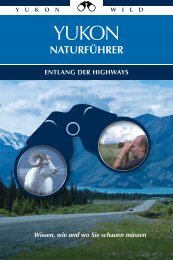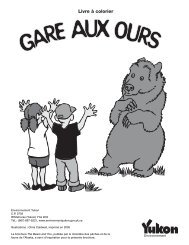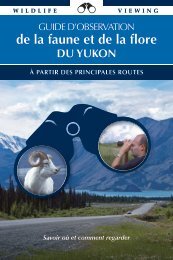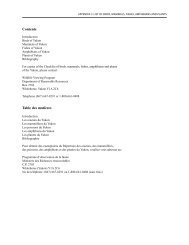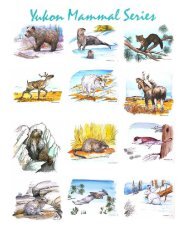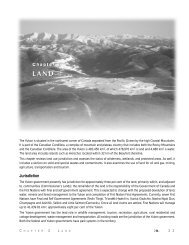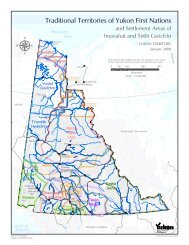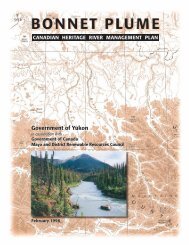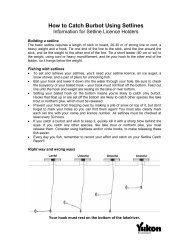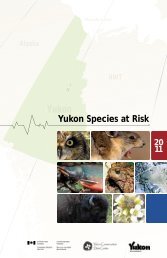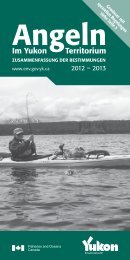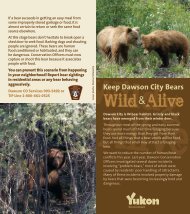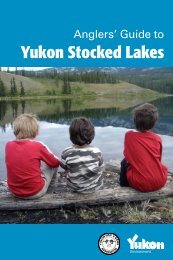Recovery of the Chisana Caribou Herd - Department of Environment
Recovery of the Chisana Caribou Herd - Department of Environment
Recovery of the Chisana Caribou Herd - Department of Environment
Create successful ePaper yourself
Turn your PDF publications into a flip-book with our unique Google optimized e-Paper software.
<strong>Recovery</strong> <strong>of</strong> <strong>the</strong> <strong>Chisana</strong> <strong>Caribou</strong> <strong>Herd</strong> in <strong>the</strong><br />
Alaska/Yukon Borderlands:<br />
Captive-Rearing Trials<br />
Prepared by<br />
<strong>Chisana</strong> <strong>Caribou</strong> <strong>Recovery</strong> Team<br />
January 2010
<strong>Recovery</strong> <strong>of</strong> <strong>the</strong> <strong>Chisana</strong> <strong>Caribou</strong> <strong>Herd</strong> in <strong>the</strong><br />
Alaska/Yukon Borderlands: Captive-Rearing Trials<br />
© 2010 Yukon <strong>Department</strong> <strong>of</strong> <strong>Environment</strong><br />
Yukon Fish and Wildlife Branch<br />
TR-10-02<br />
This technical report is intended solely to provide information for management purposes. Work<br />
reported in this series may have been peer-edited but are not peer-reviewed. Contents <strong>of</strong> this<br />
report are <strong>the</strong> responsibility <strong>of</strong> <strong>the</strong> authors and do not necessarily reflect <strong>the</strong> views, opinions or<br />
intentions <strong>of</strong> <strong>the</strong> Yukon <strong>Department</strong> <strong>of</strong> <strong>Environment</strong> or its project partners.<br />
If you want to use any portion <strong>of</strong> this report in a refereed publication, you must have<br />
permission in writing from<br />
Yukon <strong>Department</strong> <strong>of</strong> <strong>Environment</strong><br />
Fish and Wildlife Branch, V-5A<br />
Box 2703, Whitehorse, Yukon Y1A 2C6<br />
Copies available from:<br />
Yukon <strong>Department</strong> <strong>of</strong> <strong>Environment</strong><br />
Fish and Wildlife Branch, V-5A<br />
Box 2703, Whitehorse, Yukon Y1A 2C6<br />
Phone (867) 667-5721, Fax (867) 393-6263<br />
Email: environmentyukon@gov.yk.ca<br />
Also available online at www.environmentyukon.gov.yk.ca<br />
Suggested citation:<br />
<strong>Chisana</strong> <strong>Caribou</strong> <strong>Recovery</strong> Team. 2010. <strong>Recovery</strong> <strong>of</strong> <strong>the</strong> <strong>Chisana</strong> <strong>Caribou</strong> <strong>Herd</strong> in <strong>the</strong><br />
Alaska/Yukon Borderlands: Captive-Rearing Trials. Yukon Fish and Wildlife Branch Report<br />
TR-10-02.<br />
Cover Photo:<br />
<strong>Chisana</strong> caribou cow and her young calf in <strong>the</strong> captive rearing pen at Big Boundary Lake,<br />
summer 2006 (photo by Kathi Egli).
ACKNOWLEDGEMENTS<br />
Many people contributed <strong>the</strong>ir time and unique talents; without <strong>the</strong>ir<br />
help this complex effort would never have been completed. Indeed, it is <strong>the</strong><br />
good will and cooperative nature <strong>of</strong> this venture in caribou recovery that is <strong>the</strong><br />
most singular success <strong>of</strong> this project. We thank <strong>the</strong> many people who helped<br />
us capture and care for <strong>the</strong> caribou over <strong>the</strong> years <strong>of</strong> study, in particular:<br />
Gregg Adams, Shannon Barker, Larry Bill, Duane Broeren, Becky Cadsand,<br />
Trevor Castagner, Nick Demma, Dan Drummond, Kathi Egli, Nathan Ferguson,<br />
Bryanne Hoar, Patrick Johnny, Susan Kutz, Martin Kienzler, Doug Larsen,<br />
Matt Larsen, Grant Lortie, Pippa McNiel, Philip Merchant, Dan Mulcahy, Len<br />
Mychasiw, Shane Oakley, Mason Reid, Kyle Russell, and Jennifer Staniforth.<br />
Our apologies to those whose names we have missed. We are grateful to Cam<br />
Drinnan, Scott Gibbens, Chris Mauer, Harley McMahan, Doug Makkonen,<br />
Adam Morrison, Rick Swisher, Delmar Washington, and Karl Ziehe for<br />
providing excellent aircraft piloting. David Johnny, Lulu Johns, Kaz Kuba,<br />
Sandra Cairns, and Karen Clyde facilitated this project within White River First<br />
Nation Traditional Territory. David Dickson was instrumental in drawing<br />
attention toward <strong>the</strong> plight <strong>of</strong> <strong>the</strong> <strong>Chisana</strong> <strong>Caribou</strong> <strong>Herd</strong>, and in 2003 he kindly<br />
allowed use <strong>of</strong> his outfitting camp. We thank White River First Nation,<br />
Northway Tribal Council, and <strong>the</strong> US National Park Service for permission to<br />
work on <strong>the</strong>ir lands. Thomas Jung (Yukon <strong>Department</strong> <strong>of</strong> <strong>Environment</strong>,<br />
Whitehorse, Yukon) and Layne Adams (United States Geological Survey,<br />
Anchorage, Alaska) were <strong>the</strong> primary authors <strong>of</strong> this report; several members <strong>of</strong><br />
<strong>the</strong> <strong>Chisana</strong> <strong>Caribou</strong> <strong>Recovery</strong> Team (Appendix A) contributed. Jean Carey and<br />
Donna Milne kindly reviewed and formatted <strong>the</strong> report. Support was provided<br />
by Yukon <strong>Department</strong> <strong>of</strong> <strong>Environment</strong>, US Geological Survey, US National Park<br />
Service, Canadian Wildlife Service, Alaska <strong>Department</strong> <strong>of</strong> Fish and Game,<br />
White River First Nation, University <strong>of</strong> Alaska Fairbanks, Yukon Fish and<br />
Wildlife Enhancement Trust, and World Wildlife Fund.
EXECUTIVE SUMMARY<br />
We conducted trials to assess <strong>the</strong> efficacy <strong>of</strong> a captive-rearing approach<br />
to increase calf survival in <strong>the</strong> <strong>Chisana</strong> <strong>Caribou</strong> <strong>Herd</strong> (CCH), a small, declining<br />
population <strong>of</strong> woodland caribou (Rangifer tarandus caribou) in <strong>the</strong><br />
Alaska/Yukon borderlands. From 2003 to 2006, pregnant caribou cows were<br />
captured in late-winter and transferred to a holding pen established within<br />
<strong>the</strong>ir natural range. In <strong>the</strong> pen <strong>the</strong>y were protected from predators through <strong>the</strong><br />
calving and neonatal periods and <strong>the</strong>n released back into <strong>the</strong>ir natural range in<br />
mid-June. Over <strong>the</strong> 4 years, 146 caribou calves were born in captivity and 136<br />
survived to be released from <strong>the</strong> pen. Radio-telemetry was used to monitor <strong>the</strong><br />
survival <strong>of</strong> <strong>the</strong> calves raised in <strong>the</strong> pen, as well as 156 calves born to radiocollared<br />
females in <strong>the</strong> wild. Calf survival from birth through <strong>the</strong> neonatal<br />
period was about 3 times greater for caribou in <strong>the</strong> pen. After release from <strong>the</strong><br />
pen, survival <strong>of</strong> captive-reared calves to 5 months <strong>of</strong> age was 35% greater than<br />
that <strong>of</strong> caribou born in <strong>the</strong> wild, even though both groups were subjected to <strong>the</strong><br />
same conditions. Despite <strong>the</strong> success <strong>of</strong> captive-rearing in dramatically<br />
increasing survival <strong>of</strong> calves in <strong>the</strong> program, <strong>the</strong> contribution <strong>of</strong> captive-rearing<br />
to recovery <strong>of</strong> <strong>the</strong> CCH was limited by <strong>the</strong> relatively small proportion <strong>of</strong><br />
pregnant females from <strong>the</strong> herd that could be reasonably maintained in <strong>the</strong><br />
captive-rearing pen. Our results indicate that captive-rearing could be a useful<br />
management action to conserve small, at-risk populations <strong>of</strong> woodland caribou,<br />
primarily to provide time to address factors limiting population growth.
TABLE OF CONTENTS<br />
Introduction.................................................................................................... 1<br />
Methods.......................................................................................................... 2<br />
Study Population and Area .......................................................................... 2<br />
<strong>Caribou</strong> Captures ........................................................................................ 5<br />
Captive-Rearing ........................................................................................... 5<br />
Establishment and Layout <strong>of</strong> Pens ............................................................ 5<br />
<strong>Caribou</strong> Husbandry .................................................................................. 6<br />
Evaluation: Captive-Reared vs. Free-Ranging Calves .................................... 7<br />
<strong>Caribou</strong> Monitoring................................................................................... 7<br />
Statistical Analyses................................................................................... 7<br />
Evaluation: Population Dynamics................................................................. 7<br />
RESULTS........................................................................................................ 8<br />
Captive-Rearing ........................................................................................... 8<br />
Body Mass <strong>of</strong> Calves .................................................................................. 10<br />
Calf Survival .............................................................................................. 10<br />
Contribution to Calf:Cow Ratios ................................................................. 11<br />
DISCUSSION ................................................................................................ 16<br />
Individual-level Effects ............................................................................... 16<br />
Population-level Effects.............................................................................. 16<br />
MANAGEMENT IMPLICATIONS ..................................................................... 17<br />
LITERATURE CITED ..................................................................................... 18<br />
Plate 1. The capture crew secures a caribou into <strong>the</strong> orange "deer bag" to<br />
safely restrain her for <strong>the</strong> helicopter ride to <strong>the</strong> pen, April 2005. Staff<br />
bring a sedated caribou into camp, March 2003. ………………………………… 21<br />
Plate 2. Wildlife biologists process <strong>the</strong> caribou once it arrives at <strong>the</strong> pen at<br />
Boundary Lake, March 2004…………………………………………………………… 22<br />
Plate 3. <strong>Caribou</strong> in <strong>the</strong> pen at Boundary Lake with radio-collars and<br />
individual numbered visibility bands…………………………………………………. 23<br />
Plate 4. The captive-rearing pen at Big Boundary Lake in spring 2004……… 24
Plate 5. Staff constructing a tree-top observation platform (blind) within<br />
<strong>the</strong> enclosure at Boundary Lake, April 2004. Keeping a careful eye on<br />
caribou in <strong>the</strong> pen in May 2005……………………………………………………….. 25<br />
Plate 6. Students and Michelle Oakley pick lichens near <strong>the</strong> Haines<br />
Summit for transport to <strong>the</strong> pen in late-winter…………………………………….. 26<br />
Plate 7. Patrols <strong>of</strong> <strong>the</strong> enclosures for signs <strong>of</strong> predators and to check <strong>the</strong><br />
condition <strong>of</strong> <strong>the</strong> fence…………………………………………………………………….. 27<br />
Plate 8. Assessing <strong>the</strong> condition <strong>of</strong> a newly born caribou calf in <strong>the</strong> pen<br />
and applying a radio collar at Big Boundary Lake………………………………… 28<br />
Appendix A. The <strong>Chisana</strong> <strong>Caribou</strong> <strong>Recovery</strong> Team (2002–2006)…………….. 29
INTRODUCTION<br />
At <strong>the</strong> time <strong>of</strong> European settlement <strong>of</strong> North America, woodland caribou<br />
(Rangifer tarandus caribou) occurred in most conifer-dominated forested<br />
regions. Since <strong>the</strong>n, <strong>the</strong> distribution <strong>of</strong> woodland caribou has contracted<br />
northward, with some populations becoming extirpated (Schaefer 2003). Many<br />
remaining populations <strong>of</strong> woodland caribou (Rangifer tarandus caribou) are in<br />
decline (e.g. Schaefer et al. 1999, McLoughlin et al. 2003, Stronen et al. 2007).<br />
Concordant with <strong>the</strong>ir decline, most populations <strong>of</strong> woodland caribou in<br />
Canada have been legally listed as at-risk under <strong>the</strong> Canadian Species at Risk<br />
Act.<br />
Predation is a significant factor in <strong>the</strong> population dynamics <strong>of</strong> many caribou<br />
populations, particularly those that are relatively small in number and<br />
sedentary (Gasaway et al. 1983, 1992; Gauthier and Theberge 1985; Bergerud<br />
and Elliot 1986; Seip 1991, 1992; Dale et al. 1994; Adams et al. 1995a, Adams<br />
et al. 1995b; Bergerud and Elliot 1998). Predation <strong>of</strong> neonatal calves can be<br />
relatively high, particularly in <strong>the</strong> first 6 weeks after birth. For example, in<br />
Denali National Park an average <strong>of</strong> 46% <strong>of</strong> all caribou calves died within <strong>the</strong><br />
first 15 days after birth, with annual survival rates ranging from 29% to 71%<br />
(Adams et al. 1995a, Adams et al. 1995b). Populations with consistently low<br />
calf survival and recruitment may decline markedly, unless factors limiting calf<br />
survival are addressed. Typically, in nor<strong>the</strong>rn jurisdictions reducing predator<br />
populations is <strong>the</strong> most readily used management tool to increase caribou<br />
survival and stimulate population growth rates (Boertje et al. 1996; Hayes et al.<br />
2003). The public, however, have charged wildlife managers to develop<br />
management prescriptions to increase ungulate populations without lethal<br />
control <strong>of</strong> predator populations (Yukon <strong>Department</strong> <strong>of</strong> Renewable Resources<br />
1992; Hayes et al. 2003; Hayes and Couture 2004).<br />
In response to concerns from local communities and First Nations over <strong>the</strong><br />
fate <strong>of</strong> <strong>the</strong> <strong>Chisana</strong> <strong>Caribou</strong> <strong>Herd</strong> (CCH), a small declining population <strong>of</strong><br />
woodland caribou, we developed and evaluated a novel captive-rearing<br />
approach as a means <strong>of</strong> increasing calf survival and stabilizing or increasing<br />
<strong>the</strong> population growth rate <strong>of</strong> a declining caribou population. We thought that<br />
if caribou calves were born and raised through <strong>the</strong> neonatal period in <strong>the</strong><br />
protected confines <strong>of</strong> captivity, <strong>the</strong>n we could increase <strong>the</strong> number <strong>of</strong> calves in<br />
<strong>the</strong> population and associated population growth rates. For example, similar<br />
approaches have been taken to increase productivity in fish (Carr et al. 2004),<br />
sea turtle (Pelletier et al. 2003), waterfowl (Pietz and Krapu 1994; LaGrange et<br />
al. 1995) and shorebird (Mabee and Estelle 2000) populations, usually by using<br />
predator exclosures to provide safe refuge during <strong>the</strong> nesting and brood-rearing<br />
stages.<br />
Captive breeding for release back into <strong>the</strong> wild is a useful management tool<br />
for endangered species recovery, and for some species can make <strong>the</strong> difference<br />
between survival and extinction. Despite its important role for a few species,<br />
captive breeding techniques have fundamental limitations. Problems with<br />
achieving self-sustaining captive-bred populations, successful reintroductions,<br />
<strong>Recovery</strong> <strong>of</strong> <strong>the</strong> <strong>Chisana</strong> <strong>Caribou</strong> <strong>Herd</strong> in Page 1<br />
The Alaska/Yukon Borderlands: Captive-Rearing Trials
progressive domestication and genetic erosion, susceptibility to disease, high<br />
cost, and continuity restrict its use to a limited number <strong>of</strong> endangered species<br />
where o<strong>the</strong>r viable alternatives are unavailable (Snyder et al. 1996).<br />
Alternatively captive rearing and release into <strong>the</strong> wild on <strong>the</strong> species’ native<br />
range with natural fostering has potential to overcome many <strong>of</strong> <strong>the</strong>se<br />
limitations and provides ano<strong>the</strong>r approach. We believed that annual short-term<br />
(10 weeks) captive rearing in a semi-wild environment could increase <strong>the</strong> rate<br />
<strong>of</strong> recruitment to supplement populations by improving survival for neonates<br />
during <strong>the</strong> early, high-risk stages <strong>of</strong> life without <strong>the</strong> risks associated with longterm<br />
adaptation to captivity.<br />
Our intent was to hold pregnant caribou and <strong>the</strong>ir calves during <strong>the</strong> late<br />
gestation and neonatal periods, after which <strong>the</strong>y would be released from <strong>the</strong><br />
pen. If feasible and successful, captive-rearing may hold promise for increasing<br />
population growth <strong>of</strong> o<strong>the</strong>r ungulate populations that are limited by neonatal<br />
predation. To evaluate <strong>the</strong> efficacy <strong>of</strong> our captive-rearing trials, we compared<br />
survival and body mass <strong>of</strong> captive-reared calves with a sample <strong>of</strong> those born in<br />
<strong>the</strong> wild.<br />
METHODS<br />
Study Population and Area<br />
The CCH is a small herd that ranges along <strong>the</strong> borderlands <strong>of</strong> western<br />
Yukon and eastern Alaska, near <strong>the</strong> headwaters <strong>of</strong> <strong>the</strong> White River in <strong>the</strong><br />
Nutzotin Mountains (Figure 1). Zittlau et al. (2000) used DNA analyses to<br />
demonstrate that <strong>the</strong> CCH is relatively genetically distinct from neighbouring<br />
caribou herds. During <strong>the</strong> 1990s, local outfitters and communities were<br />
concerned that <strong>the</strong> CCH was in rapid decline. Based on limited survey data,<br />
Farnell and Gardner (2002) estimated that <strong>the</strong> CCH declined from about 1900<br />
caribou in 1988 to a low <strong>of</strong> about 400 in 2001, and that calf:cow and bull:cow<br />
ratios had also declined markedly (Figure 2). Fur<strong>the</strong>r, <strong>the</strong>re was evidence that<br />
<strong>the</strong> age structure <strong>of</strong> cows was skewed to older age-classes that were beyond<br />
<strong>the</strong>ir prime as a result <strong>of</strong> over a decade <strong>of</strong> poor calf recruitment (Farnell and<br />
Gardner 2002). Demographic data suggested that <strong>the</strong> CCH was much reduced<br />
in numbers, and that current calf recruitment would not sustain <strong>the</strong> herd in<br />
<strong>the</strong> long-term. Fur<strong>the</strong>rmore, nuclear DNA data does not indicate mixing with<br />
any neighbouring herds; thus demographic “rescue” from neighbouring herds<br />
was not likely (Farnell and Gardner 2002).<br />
The study area was within <strong>the</strong> Alaska-St. Elias Range Tundra Ecoregion<br />
(Ricketts et al. 1999), south <strong>of</strong> Beaver Creek, Yukon (62.38º N, 140.88º W). The<br />
area is characterized by rugged and glaciated mountains with many peaks<br />
rising to 2500 m. The herd’s range is drained by <strong>the</strong> Donjek, Generc, White,<br />
<strong>Chisana</strong>, and Nabesna rivers (Figure 1). Treeline generally occurs at 1,050–<br />
1,200 m. White spruce (Picea glauca) dominates well-drained soils, while<br />
stunted black spruce (Picea mariana) is common on poorly drained sites. White<br />
birch (Betula papyrifera), trembling aspen (Populus tremuloides), and balsam<br />
poplar (P. balsamifera) are found in warmer lowland areas. Willow (Salix spp.),<br />
<strong>Recovery</strong> <strong>of</strong> <strong>the</strong> <strong>Chisana</strong> <strong>Caribou</strong> <strong>Herd</strong> in Page 2<br />
The Alaska/Yukon Borderlands: Captive-Rearing Trials
dwarf birch (Betula spp.), soapberry (Shepherdia canadensis), and ericaceous<br />
shrubs (e.g. Vaccinium spp., Ledum spp.) dominate understory, riparian, and<br />
subalpine regions. Sedge–tussock fields are common in poorly drained sites<br />
and gentle slopes. Steeper slopes give way to alpine forbs, ericaceous shrubs,<br />
grasses, and lichens. The CCH range is within <strong>the</strong> rain shadow <strong>of</strong> <strong>the</strong> St. Elias<br />
Mountains and is classified as a dry, cold, continental climate, receiving an<br />
average <strong>of</strong> 32 cm <strong>of</strong> annual precipitation. At Beaver Creek, annual snowfall<br />
averages approximately 132 cm, and mean annual temperature is –6.6ºC.<br />
Figure 1. Range <strong>of</strong> <strong>the</strong> <strong>Chisana</strong> <strong>Caribou</strong> <strong>Herd</strong> in western Yukon and eastern Alaska, and<br />
location <strong>of</strong> <strong>the</strong> Tchawsahmon Lake and Big Boundary Lake project locations where captiverearing<br />
pens were established in 2003 and 2004–2006, respectively.<br />
<strong>Recovery</strong> <strong>of</strong> <strong>the</strong> <strong>Chisana</strong> <strong>Caribou</strong> <strong>Herd</strong> in Page 3<br />
The Alaska/Yukon Borderlands: Captive-Rearing Trials
A.<br />
B.<br />
C.<br />
Estimated Population Size (No. <strong>of</strong> <strong>Caribou</strong>)<br />
Calves per 100 Cows<br />
Bulls per 100 Cows<br />
2000<br />
1800<br />
1600<br />
1400<br />
1200<br />
1000<br />
800<br />
600<br />
400<br />
200<br />
35<br />
30<br />
25<br />
20<br />
15<br />
10<br />
5<br />
0<br />
50<br />
40<br />
30<br />
20<br />
10<br />
0<br />
1986<br />
1987<br />
1988<br />
1989<br />
1990<br />
1991<br />
1992<br />
1993<br />
Survey Year<br />
Figure 2. A) Estimated trend in population size <strong>of</strong> <strong>the</strong> <strong>Chisana</strong> <strong>Caribou</strong> <strong>Herd</strong> and B) calves per<br />
100 cows and C) bulls per 100 cows for 1987–2001. Data from Farnell and Gardner (2003).<br />
<strong>Recovery</strong> <strong>of</strong> <strong>the</strong> <strong>Chisana</strong> <strong>Caribou</strong> <strong>Herd</strong> in Page 4<br />
The Alaska/Yukon Borderlands: Captive-Rearing Trials<br />
1994<br />
1995<br />
1996<br />
1997<br />
1998<br />
1999<br />
2000<br />
2001<br />
2002
Woodland caribou in this area are important to local First Nations, both<br />
culturally and as a food source. The CCH is also an important component <strong>of</strong><br />
<strong>the</strong> area’s ecosystem. Toge<strong>the</strong>r with moose (Alces americanus), thinhorn sheep<br />
(Ovis dalli), and smaller prey such as snowshoe hare (Lepus americanus), <strong>the</strong>y<br />
support a diverse mix <strong>of</strong> predators and scavengers, including wolves (Canis<br />
lupus; 5.6/1000 km 2 ; R. Farnell & C. Gardner, unpublished data), brown bears<br />
(Ursus arctos; 16–18/1000 km 2 ; C. Gardner, unpublished data), American<br />
black bears (Ursus americana), Canada lynx (Lynx canadensis), coyotes (Canis<br />
latrans), wolverines (Gulo gulo), and golden eagles (Aquila chrysaetos). Moose<br />
and sheep are likely <strong>the</strong> common alternate prey species in <strong>the</strong> CCH range.<br />
Moose density was estimated at 230/1000 km 2 in 1998 (C. Gardner,<br />
unpublished data) and sheep density was 1.05/km 2 <strong>of</strong> habitable sheep range<br />
(Sumanik 1987).<br />
<strong>Caribou</strong> Captures<br />
From 2003 to 2006 we captured adult female caribou in late-March to<br />
early-April to stock <strong>the</strong> captive rearing pen. A fixed-wing aircraft was used to<br />
search for caribou with radio-telemetry and in areas identified through<br />
previous field surveys and local knowledge. <strong>Caribou</strong> were captured via a netgun<br />
fired from a Bell 206B helicopter (Barret et al. 1982). In all years, captured<br />
caribou were blind-folded, <strong>the</strong>ir legs were bound and <strong>the</strong>y were restrained in<br />
bag for transport (Plate 1). We also sawed <strong>of</strong>f a portion <strong>of</strong> <strong>the</strong>ir antlers in 2004–<br />
2006 to reduce risk <strong>of</strong> injury to handlers and damage to helicopters. <strong>Caribou</strong><br />
were transported inside a helicopter to <strong>the</strong> capture pen (see below; Plate 1). In<br />
<strong>the</strong> second year <strong>of</strong> <strong>the</strong> project (2004), we experimented with using a chemical<br />
sedative to reduce <strong>the</strong> stress on animals (and <strong>the</strong>ir handlers), subjecting half <strong>of</strong><br />
<strong>the</strong> animals to <strong>the</strong> chemical sedation using an intranasal administration <strong>of</strong><br />
medetomidine at a dosage <strong>of</strong> 10–13 mg/caribou. Results from this trial<br />
demonstrated that sedated caribou were easier to handle and less stressed<br />
than non-sedated caribou (M. Oakley et al., unpublished data); thus in <strong>the</strong> last<br />
2 years <strong>of</strong> <strong>the</strong> program (2005–2006) all caribou transported from <strong>the</strong> capture<br />
site to <strong>the</strong> pen were sedated after capture by net gun. Only cows determined<br />
pregnant by ultrasound were placed in <strong>the</strong> pen, although in 2003, 3<br />
nonproductive cows were kept based on unclear ultrasound results. Once at<br />
<strong>the</strong> pen facility, all cows were thoroughly examined; various physiological,<br />
morphological, and body condition measures were recorded; biological samples<br />
(e.g. blood, feces, teeth, etc.) were taken; and each animal was fitted with a<br />
radio-collar, plastic ear tag, and uniquely numbered visibility band (see Plates<br />
2 and 3). Sedated animals were given <strong>the</strong> appropriate antagonist (atipamezole<br />
at 30–40 mg/caribou) and pregnant individuals were released into <strong>the</strong> pen.<br />
Captive-Rearing<br />
Establishment and Layout <strong>of</strong> Pens<br />
Pens were established in late-winter prior to captures, and were located<br />
at remote sites within <strong>the</strong> herd’s winter range (Plate 4). Sites for constructing<br />
<strong>Recovery</strong> <strong>of</strong> <strong>the</strong> <strong>Chisana</strong> <strong>Caribou</strong> <strong>Herd</strong> in Page 5<br />
The Alaska/Yukon Borderlands: Captive-Rearing Trials
<strong>the</strong> pens were selected to ensure that <strong>the</strong>y had enough large trees to both act<br />
as fence posts and to provide cover for caribou to give birth, rest, and shelter<br />
from inclement wea<strong>the</strong>r; were open enough to provide visibility so that <strong>the</strong><br />
penned animals could be adequately monitored; and provided access to water<br />
and natural forage. In 2003, we established a pen at Tchawsahmon Lake,<br />
about 45 km south <strong>of</strong> Beaver Creek, Yukon (62.38º N, 140.88º W); to reduce<br />
transportation time <strong>of</strong> captured caribou, we located <strong>the</strong> pen at Boundary Lake<br />
in 2004–2006, about 80 km south <strong>of</strong> Beaver Creek, Yukon (Figure 1). The later<br />
location was within <strong>the</strong> core winter and early summer range, which reduced<br />
transport times to <strong>the</strong> pen for captured animals, and put penned caribou closer<br />
to where <strong>the</strong> rest <strong>of</strong> <strong>the</strong>ir herd normally would be at <strong>the</strong> time <strong>of</strong> release from <strong>the</strong><br />
pen. Pen sizes for 2003–2006 were 6.0, 9.5, 12.0, and 12.2 ha, respectively.<br />
Pens were fenced using a 2.29 m tall black geotextile cloth (LP 200,<br />
Layfield Geosyn<strong>the</strong>tics & Industrial Fabrics Ltd., Edmonton, Alberta; Plate 4),<br />
which acted primarily as a psychological barrier to caribou and potential<br />
predators (e.g. Musiani et al. 2003), ra<strong>the</strong>r than an impermeable physical<br />
barrier (such as standard game or livestock fencing). The geotextile cloth was<br />
hung on cables tightly stretched between suitable trees, or 2.43 m tall rough<br />
fence posts, spaced approximately 20 m apart. We tried to route <strong>the</strong> fenceline<br />
along <strong>the</strong> top <strong>of</strong> ridgelines to make <strong>the</strong> fence appear higher and more<br />
formidable, and to limit <strong>the</strong> possibilities <strong>of</strong> ei<strong>the</strong>r caribou or predators looking<br />
over <strong>the</strong> fence. A 3–4 wire electric fence (Margo Supplies Ltd., High River,<br />
Alberta) surrounded <strong>the</strong> geotextile fence to provide fur<strong>the</strong>r predator deterrence.<br />
We built 1 or 2 tree stands about 3–5 m above <strong>the</strong> ground and in or<br />
immediately adjacent to <strong>the</strong> pen to increase our ability to view and monitor<br />
penned caribou (Plate 5). Tree stands were located on high spots within <strong>the</strong> pen<br />
to maximize <strong>the</strong>ir effectiveness in covering <strong>the</strong> large enclosures. Wooden<br />
feeding troughs were placed in easy view from <strong>the</strong> tree stands to facilitate<br />
monitoring <strong>of</strong> caribou in <strong>the</strong> pen.<br />
<strong>Caribou</strong> Husbandry<br />
Penned caribou remained in captivity from late-March until mid-June<br />
each year. While in <strong>the</strong> pen, <strong>the</strong>y were fed terrestrial lichens, a commercial<br />
pellet ration specifically for caribou, and foraged on native vegetation within <strong>the</strong><br />
fence line. Terrestrial lichens (e.g. Cladina stellaris, C. mitis, C. arbuscula) were<br />
transported to <strong>the</strong> pen, after being picked <strong>the</strong> previous fall (<strong>of</strong>ten by local<br />
school children; see Plate 6), and placed in dry storage. Lichen and pellets were<br />
distributed twice daily at 12 hour intervals in feeding troughs. Pellets were<br />
introduced within <strong>the</strong> first week <strong>of</strong> captivity and increased gradually to avoid<br />
digestive problems. Inspection <strong>of</strong> fresh fecal piles in <strong>the</strong> pen and visual<br />
observation <strong>of</strong> caribou during daily monitoring provided guidance on how well<br />
animals were adapting to pellet feed. Beginning in 2005, we used electronic<br />
platform scales (Bassano et al. 2003) placed near feeding troughs to weigh<br />
caribou. During <strong>the</strong> last week <strong>of</strong> captivity, prior to release, <strong>the</strong> proportion <strong>of</strong><br />
lichen fed was increased in preparation for <strong>the</strong> transition to a natural diet.<br />
Supplemental salt and o<strong>the</strong>r micronutrients (e.g. selenium) were provided by<br />
<strong>Recovery</strong> <strong>of</strong> <strong>the</strong> <strong>Chisana</strong> <strong>Caribou</strong> <strong>Herd</strong> in Page 6<br />
The Alaska/Yukon Borderlands: Captive-Rearing Trials
placing standard 20 kg salt blocks in <strong>the</strong> pen. After snow melt, in cases where<br />
a natural water source was not available in <strong>the</strong> pen, water was provided in<br />
open containers or from a water line with continuous flow.<br />
Penned caribou were monitored at least twice a day, usually via visual<br />
observations from <strong>the</strong> tree stands (Plate 5) or fence perimeter. In cases where<br />
individuals could not be located visually, we used radio-telemetry to ensure<br />
<strong>the</strong>y were indeed in <strong>the</strong> pen and alive. Additionally, <strong>the</strong> perimeter <strong>of</strong> <strong>the</strong> pen<br />
was checked at least twice daily to ensure <strong>the</strong> integrity <strong>of</strong> <strong>the</strong> geotextile cloth<br />
and to look for signs <strong>of</strong> potential predators (Plate 7). Regular human presence<br />
around <strong>the</strong> fenceline was also believed to help deter bears and wolves from<br />
approaching <strong>the</strong> pen.<br />
Evaluation: Captive-Reared vs. Free-Ranging Calves<br />
<strong>Caribou</strong> Monitoring<br />
We assessed <strong>the</strong> efficacy <strong>of</strong> captive-rearing in producing healthy calves<br />
that survive beyond <strong>the</strong> neonatal period by comparing survival and body mass<br />
<strong>of</strong> calves born in <strong>the</strong> pen with a sample <strong>of</strong> calves born to free-ranging cows.<br />
Calves born in <strong>the</strong> pen were captured by hand and examined (see Plate 8),<br />
generally within a day <strong>of</strong> birth. Calves were weighed (± 0.1 kg) using a spring<br />
scale and affixed with a VHF radio-transmitter on an expandable collar. Their<br />
status was checked daily, both visually and with ground-based telemetry. Once<br />
released, pen-reared calves were located periodically via aerial telemetry to<br />
assess <strong>the</strong>ir survival.<br />
A comparable sample <strong>of</strong> free-ranging calves were captured and weighed<br />
as described by Adams et al. (1995b). Radio-collared cows ≥ 2 years old in <strong>the</strong><br />
free-ranging population were observed from helicopters shortly after <strong>the</strong> peak <strong>of</strong><br />
calving (≈ 20 May) to determine whe<strong>the</strong>r <strong>the</strong>y were pregnant or not based on<br />
<strong>the</strong> presence <strong>of</strong> a calf at heel, a distended udder, and/or hard antler (Whitten<br />
1995). To assess calf survival in <strong>the</strong> wild, each cow that was deemed parturient<br />
was located periodically throughout <strong>the</strong> summer and fall to determine if it was<br />
accompanied by a calf.<br />
Statistical Analyses<br />
Contingency table analysis was used to compare survival <strong>of</strong> captivereared<br />
calves and wild-born calves a) from birth to release from <strong>the</strong> pen<br />
(approximately 15 May – 15 June - <strong>the</strong> neonatal period); b) from release until<br />
mid-fall (approximately 15 October – 3 months since release); and c) both time<br />
periods combined. High mortality rates <strong>of</strong> wild-born calves resulted in sample<br />
sizes too small for statistical analyses within each year; <strong>the</strong>refore, we pooled<br />
samples across years. Body mass was compared among year and treatment<br />
(captive-reared or wild-born calves) using a factorial analysis (e.g. ANOVA).<br />
Evaluation: Population Dynamics<br />
The number <strong>of</strong> calves recruited into <strong>the</strong> population at 5 months <strong>of</strong> age<br />
(mid-October) was used to assess <strong>the</strong> relative contribution <strong>of</strong> captive-rearing to<br />
<strong>the</strong> demography <strong>of</strong> <strong>the</strong> population. Fall calf:cow ratios from 1987 to 2002 were<br />
<strong>Recovery</strong> <strong>of</strong> <strong>the</strong> <strong>Chisana</strong> <strong>Caribou</strong> <strong>Herd</strong> in Page 7<br />
The Alaska/Yukon Borderlands: Captive-Rearing Trials
summarized by Farnell and Gardner (2002). Additional fall composition counts<br />
were conducted from a Robinson R-44 helicopter in October 2003–2006 to<br />
derive calf:cow ratios and o<strong>the</strong>r demographic data. Data were tabulated to<br />
assess <strong>the</strong> percent <strong>of</strong> calves present in fall that were captive-reared or wildborn.<br />
RESULTS<br />
Captive-Rearing<br />
In 2003–2006, 175 adult female caribou were captured for possible<br />
transfer to <strong>the</strong> pen (Table 1). Five cows died from capture-related causes,<br />
including 3 that died immediately following capture (1 in 2003, 2 in 2004), and<br />
2 that died within a few days following capture (1 in 2004, 1 in 2005), probably<br />
as a result <strong>of</strong> stress-induced capture myopathy (Chalmers and Barrett 1982).<br />
Sedation <strong>of</strong> caribou in 2004–2006 noticeably reduced stress to animals during<br />
transport and handling (M. Oakley et al., unpublished data), and presumably<br />
reduced <strong>the</strong> risk <strong>of</strong> capture myopathy.<br />
Table 1. Summary data for <strong>Chisana</strong> caribou captured and captive-reared, western<br />
Yukon / eastern Alaska, 2003–2006.<br />
Variable<br />
Year<br />
2003 2004 2005 2006<br />
Number <strong>of</strong> Cows Captured 22 A 37 B 58 C 58 D<br />
Number <strong>of</strong> Cows in <strong>the</strong> Pen 20 E 29 50 50<br />
Number <strong>of</strong> Pregnant Cows in <strong>the</strong> Pen 17 29 50 50<br />
Number <strong>of</strong> Calves Born in <strong>the</strong> Pen 17 29 50 50<br />
Number <strong>of</strong> Calves Released from <strong>the</strong><br />
Pen<br />
17 29 45 45<br />
A 1 cow died during capture operations and was not transported to <strong>the</strong> pen.<br />
B 6 cows were not pregnant and were released; 2 cows died from capturerelated<br />
causes.<br />
C 7 cows were not pregnant and were released; 1 cow died following capture<br />
from capture myopathy.<br />
D 8 cows were not pregnant.<br />
E Pregnancy determination via ultrasound were equivocal for 3 cows placed in<br />
<strong>the</strong> pen; <strong>the</strong>y did not produce calves.<br />
<strong>Recovery</strong> <strong>of</strong> <strong>the</strong> <strong>Chisana</strong> <strong>Caribou</strong> <strong>Herd</strong> in Page 8<br />
The Alaska/Yukon Borderlands: Captive-Rearing Trials
We captured and cared for 20, 29, 50, and 50 adult caribou in <strong>the</strong> pen in<br />
2003–2006, respectively (Table 1). Cows appeared to adjust well to captivity<br />
and <strong>the</strong> mixture <strong>of</strong> natural and commercial feed, as <strong>the</strong>y gained 10% and 6% in<br />
body mass in 2005 and 2006, respectively, between capture and 30 April (L.<br />
Adams, unpublished data), a period <strong>of</strong> late winter when wild caribou were<br />
probably losing body mass. With <strong>the</strong> exception <strong>of</strong> 3 cows in 2003 that were not<br />
pregnant, all <strong>of</strong> <strong>the</strong> penned cows gave birth (Table 1). Captive rearing in 2003–<br />
2006 resulted in 146 calves being born in <strong>the</strong> pen (Table 1). Calving occurred<br />
as early as 7 May and continued as late as 8 June, but most cows in <strong>the</strong> pen<br />
were relatively synchronous, with a strong peak in calving occurring 16–20<br />
May in each year (Figure 3).<br />
Percent <strong>of</strong> Calves Born (%)<br />
50<br />
40<br />
30<br />
20<br />
10<br />
0<br />
5-10 May<br />
11-15 May<br />
16-20 May<br />
21-25 May<br />
26-31 May<br />
1-5 June<br />
2003<br />
2004<br />
2005<br />
2006<br />
Figure 3. Percent <strong>of</strong> calves born in <strong>the</strong> pen during 5-day intervals in 2003 (n = 17), 2004 (n =<br />
29), 2005 (n = 50), and 2006 (n = 49) during captive-rearing trails.<br />
<strong>Recovery</strong> <strong>of</strong> <strong>the</strong> <strong>Chisana</strong> <strong>Caribou</strong> <strong>Herd</strong> in Page 9<br />
The Alaska/Yukon Borderlands: Captive-Rearing Trials<br />
5-10 June
The geocloth and electronic fence formed an adequate pen and, with 1<br />
exception, caribou did not escape during <strong>the</strong> 4 years <strong>of</strong> captive-rearing trials. In<br />
June 2006, 1 calf escaped from <strong>the</strong> pen and its mo<strong>the</strong>r was released from <strong>the</strong><br />
pen to care for it. There was limited evidence <strong>of</strong> predators being attracted to <strong>the</strong><br />
pen in most years. However, in 2003, we deterred 1 grizzly bear, while in 2004<br />
we deterred 7 grizzly bears and 1 wolf, and in 2005, 1 golden eagle was<br />
deterred. In 2006, a black bear got into <strong>the</strong> pen and was shot and killed after<br />
killing a calf. However, <strong>the</strong>re may have been a number <strong>of</strong> o<strong>the</strong>r instances for<br />
which predators were deterred but not detected. Ravens (Corvus corax), bald<br />
eagles (Haliaeetus leucocephalus), marten (Martes americana) and red fox<br />
(Vulpes vulpes) were observed feeding on placentas shed by caribou in <strong>the</strong> pen.<br />
Marten and red fox were also observed feeding on caribou that had recently<br />
died from o<strong>the</strong>r causes in <strong>the</strong> pen.<br />
Body Mass <strong>of</strong> Calves<br />
The estimated birth masses <strong>of</strong> calves differed among male and female<br />
calves (F1,216 = 20.17, P < 0.001), with females being about 15% lighter than<br />
males, and varied among years with calves born in 2005 lighter than o<strong>the</strong>r<br />
years (15% and 6% lighter for males and females, respectively; F2,216 = 26.14,<br />
P < 0.001). We did not detect any differences in mass at birth between captivereared<br />
and wild-born calves (F1,216 = 2.65, P = 0.105 ; Table 2).<br />
Table 2. Birth mass (kg) <strong>of</strong> calves born in <strong>the</strong> captive-rearing facilities and free-ranging<br />
calves <strong>of</strong> <strong>the</strong> <strong>Chisana</strong> <strong>Caribou</strong> <strong>Herd</strong>, Alaska-Yukon borderlands, 2004 – 2006.<br />
Pen Wild<br />
Male Female Male Female<br />
x n SD x n SD x n SD x n SD<br />
2004 9.5 11 1.33 8.0 16 1.15 9.6 12 1.62 8.9 12 1.62<br />
2005 8.5 24 1.40 7.5 24 1.32 8.1 14 1.26 7.7 26 1.22<br />
2006 9.6 24 1.24 8.8 22 0.99 9.5 16 1.28 9.7 15 1.03<br />
Calf Survival<br />
Survival <strong>of</strong> calves in <strong>the</strong> pen was very high overall (93%). In 2003 and<br />
2004, all <strong>the</strong> calves survived to release, but in 2005 and 2006, 5 calves died or<br />
were abandoned in each year. In 2005, 2 calves died within < 1 day birth, 1<br />
was abandoned and died about a week after birth, 1 was abandoned at a<br />
couple <strong>of</strong> days <strong>of</strong> age and was taken to <strong>the</strong> Yukon Game Farm where it thrived,<br />
and 1 calf was euthanized at about 3 weeks <strong>of</strong> age due to a compound leg<br />
fracture; this individual was also exhibiting suspected neurological problems.<br />
In 2006, 2 calves were stillborn, ano<strong>the</strong>r was ei<strong>the</strong>r stillborn or killed by a<br />
small predator (e.g. red fox), 1 was killed by a black bear, and 1 calf was<br />
abandoned when its mo<strong>the</strong>r died from birth complications; this calf was taken<br />
to <strong>the</strong> Yukon Wildlife Preserve, but it exhibited serious neurological problems<br />
and was ultimately euthanized.<br />
<strong>Recovery</strong> <strong>of</strong> <strong>the</strong> <strong>Chisana</strong> <strong>Caribou</strong> <strong>Herd</strong> in Page 10<br />
The Alaska/Yukon Borderlands: Captive-Rearing Trials
The free-ranging, radio-collared cows we monitored in <strong>the</strong> CCH produced<br />
156 calves during <strong>the</strong> 4 years <strong>of</strong> <strong>the</strong> captive-rearing program. Captive-rearing<br />
had a pr<strong>of</strong>ound effect on short-term survival <strong>of</strong> calves. For <strong>the</strong> neonatal period<br />
(birth to mid-June release), <strong>the</strong> survival <strong>of</strong> pen calves (93%) was significantly<br />
greater than wild-born calves (33%; X21 = 114.84; P < 0.001; Figure 4). The<br />
causes <strong>of</strong> mortality for calves born in <strong>the</strong> wild were unknown, but it is<br />
presumed that <strong>the</strong>y died predominantly from wolf and grizzly bear predation,<br />
based on studies <strong>of</strong> similar caribou herds (Adams et al. 1995a, Adams et al.<br />
1995b; Valkenburg et al. 2004; Jenkins and Barten 2005). Survival from <strong>the</strong><br />
time <strong>of</strong> release (approximately 15 June) until mid-October was also greater for<br />
calves born in <strong>the</strong> pen (70% compared to those born in <strong>the</strong> wild (52%; X21 =<br />
5.31; P = 0.021; Figure 5), even though both groups <strong>of</strong> caribou were freeranging<br />
and presumably equally exposed to predators. Considering <strong>the</strong> entire<br />
monitoring period, spanning from birth until about 5 months <strong>of</strong> age, a much<br />
higher percentage <strong>of</strong> calves born in <strong>the</strong> pen survived until 15 October (65%)<br />
than calves born in <strong>the</strong> wild (17%; X21 = 71.45; P < 0.001; Figure 6).<br />
Contribution to Calf:Cow Ratios<br />
Calf:cow ratios varied over <strong>the</strong> period 1987 to 2006 (Figure 7). In <strong>the</strong> 14year<br />
period immediately prior to <strong>the</strong> onset <strong>of</strong> recovery efforts for <strong>the</strong> CCH<br />
(1987–2002), calf:cow ratios were exceedingly low (mean = 6.3 calves:100 cows,<br />
range = 0–14:100; Figure 7). Coinciding with our recovery efforts, in 2003–2006<br />
calf:cow ratios naturally increased markedly (mean = 18.2 calves:100 cows,<br />
range 15–24:100; Figure 7), without <strong>the</strong> contribution <strong>of</strong> captive-rearing efforts.<br />
Regardless, captive-rearing provided a substantial contribution ranging from<br />
7% – 32% to <strong>the</strong> observed calf:cow ratios in 2003–2006 (Figure 7).<br />
<strong>Recovery</strong> <strong>of</strong> <strong>the</strong> <strong>Chisana</strong> <strong>Caribou</strong> <strong>Herd</strong> in Page 11<br />
The Alaska/Yukon Borderlands: Captive-Rearing Trials
A.<br />
B.<br />
Percent Surviving (%)<br />
Percent Survival (%)<br />
100<br />
80<br />
60<br />
40<br />
20<br />
0<br />
100<br />
80<br />
60<br />
40<br />
20<br />
0<br />
2003 2004 2005 2006<br />
Days vs Pen Born<br />
Days vs Wild Born<br />
Birth Release<br />
Time Period<br />
Figure 4. A) Percent <strong>of</strong> calves born in <strong>the</strong> pen surviving from birth (~ May 25) to release from<br />
<strong>the</strong> pen (~ June 15), compared to calves born in <strong>the</strong> wild and monitored during <strong>the</strong> same time<br />
period. B) Pooled survival <strong>of</strong> calves in 2003–2006 born in <strong>the</strong> pen (n = 146 calves) and in <strong>the</strong><br />
wild (n = 156 calves) that survived from birth to release <strong>of</strong> penned animals.<br />
<strong>Recovery</strong> <strong>of</strong> <strong>the</strong> <strong>Chisana</strong> <strong>Caribou</strong> <strong>Herd</strong> in Page 12<br />
The Alaska/Yukon Borderlands: Captive-Rearing Trials<br />
Year<br />
Calves Born in <strong>the</strong> Pen<br />
Calves Born in <strong>the</strong> Wild
A.<br />
B.<br />
Percent Surviving (%)<br />
Percent Surviving (%)<br />
100<br />
80<br />
60<br />
40<br />
20<br />
0<br />
100<br />
80<br />
60<br />
40<br />
20<br />
0<br />
Calves Born in <strong>the</strong> Pen<br />
Calves Born in <strong>the</strong> Wild<br />
2003 2004 2005 2006<br />
Year<br />
Calves Born in <strong>the</strong> Pen<br />
Calves Born in <strong>the</strong> Wild<br />
0 20 40 60 80 100 120<br />
Days Since Release<br />
Figure 5. A) Percent <strong>of</strong> calves born in <strong>the</strong> pen surviving from release from <strong>the</strong> pen (~ June 15),<br />
until early fall (~ October 15), compared to calves born in <strong>the</strong> wild and monitored during <strong>the</strong><br />
same time period. B) Pooled survival <strong>of</strong> calves across years (2003–2006) released from <strong>the</strong> pen<br />
(n = 136 calves) and calves born in <strong>the</strong> wild (n = 52 calves) that survived from release <strong>of</strong> <strong>the</strong><br />
penned calves (~ 15 June) until fall (~ 15 October ; 4 months post-release).<br />
<strong>Recovery</strong> <strong>of</strong> <strong>the</strong> <strong>Chisana</strong> <strong>Caribou</strong> <strong>Herd</strong> in Page 13<br />
The Alaska/Yukon Borderlands: Captive-Rearing Trials
B.<br />
A.<br />
Percent Surviving (%)<br />
Percent Surviving (%)<br />
100<br />
80<br />
60<br />
40<br />
20<br />
0<br />
100<br />
80<br />
60<br />
40<br />
20<br />
0<br />
2003 2004 2005 2006<br />
Year<br />
-20 0 20 40 60 80 100 120<br />
Days Since Release<br />
Calves Born in <strong>the</strong> Pen<br />
Calves Born in <strong>the</strong> Wild<br />
Born in <strong>the</strong> Pen<br />
Born in <strong>the</strong> Wild<br />
Figure 6. A) Percent <strong>of</strong> calves born in <strong>the</strong> pen surviving from birth until early fall (~ October 15),<br />
compared to calves born in <strong>the</strong> wild and monitored during <strong>the</strong> same time period. Numbers<br />
above <strong>the</strong> bars is <strong>the</strong> number <strong>of</strong> radio-collared calves monitored. B) Pooled survival <strong>of</strong> calves<br />
across years (2003–2006) born in <strong>the</strong> pen (n = 146 calves) and radio-collared calves born in <strong>the</strong><br />
wild (n = 156 calves) that survived from birth until fall (~ 15 October ; 4 months post-release).<br />
<strong>Recovery</strong> <strong>of</strong> <strong>the</strong> <strong>Chisana</strong> <strong>Caribou</strong> <strong>Herd</strong> in Page 14<br />
The Alaska/Yukon Borderlands: Captive-Rearing Trials
Number <strong>of</strong> Calves:100 Cows<br />
35<br />
30<br />
25<br />
20<br />
15<br />
10<br />
5<br />
0<br />
1987<br />
1988<br />
1989<br />
1990<br />
1991<br />
1992<br />
1993<br />
1994<br />
1995<br />
1996<br />
1997<br />
1998<br />
1999<br />
2000<br />
2001<br />
2002<br />
2003<br />
2004<br />
2005<br />
2006<br />
Figure 7. Number <strong>of</strong> calves per 100 cows observed during fall composition surveys <strong>of</strong> <strong>the</strong><br />
<strong>Chisana</strong> <strong>Caribou</strong> <strong>Herd</strong>, 1987–2006. Shaded portions <strong>of</strong> <strong>the</strong> bars for 2003–2006 indicate <strong>the</strong><br />
annual contribution <strong>of</strong> captive-reared calves to observed calf : cow ratios. Data for 1987 – 2002<br />
from Farnell and Gardner (2002).<br />
<strong>Recovery</strong> <strong>of</strong> <strong>the</strong> <strong>Chisana</strong> <strong>Caribou</strong> <strong>Herd</strong> in Page 15<br />
The Alaska/Yukon Borderlands: Captive-Rearing Trials
DISCUSSION<br />
Individual-level Effects<br />
Our 4 years <strong>of</strong> captive-rearing trials demonstrated that woodland caribou<br />
could be captured and put into temporary pens within <strong>the</strong>ir range for short<br />
periods <strong>of</strong> <strong>the</strong> annual cycle, could give birth and raise calves over <strong>the</strong> neonatal<br />
period, and <strong>the</strong>n be successfully released into <strong>the</strong> wild. Using what amounted<br />
to primarily a psychological barrier, we were able to keep caribou cows within<br />
<strong>the</strong> pen for over 2.5 months each year, and predators out, effectively reducing<br />
predation on pregnant cows and newborn calves. In situ captive-rearing on<br />
native range appeared to <strong>of</strong>fer a feasible alternative to ex situ captive-breeding<br />
with unnatural fostering and subsequent reintroduction into <strong>the</strong> wild. Cows<br />
and <strong>the</strong>ir calves never left <strong>the</strong>ir natal range to be bred in captivity, thus <strong>the</strong>re<br />
was no associated concerns about genetic loss, artificial selection, transfer <strong>of</strong><br />
diseases, or loss <strong>of</strong> natural instincts that are common to more standard ex situ<br />
captive-breeding and reintroduction programs for endangered populations.<br />
The primary goal <strong>of</strong> our work was to evaluate <strong>the</strong> efficacy <strong>of</strong> in situ<br />
captive-rearing as a means to increase neonatal calf survival in a small,<br />
declining woodland caribou herd. Survival rates <strong>of</strong> calves born in <strong>the</strong> pen over<br />
<strong>the</strong> neonatal period were nearly 3 times greater than that for calves born to<br />
free-ranging cows, demonstrating that our captive-rearing trials were<br />
successful in markedly increasing neonatal survival <strong>of</strong> captive-reared calves.<br />
However, even if calf survival over <strong>the</strong> neonatal period was increased, if calves<br />
did not survive to recruit into <strong>the</strong> population after release from <strong>the</strong> pen, <strong>the</strong>n,<br />
<strong>the</strong> contribution <strong>of</strong> captive-rearing to calf survival would be negligible. Through<br />
monitoring <strong>of</strong> calves born in <strong>the</strong> pen and those born to free-ranging cows,<br />
captive-rearing had a positive effect on survival <strong>of</strong> calves even after release from<br />
<strong>the</strong> pen. Survival rates after release were approximately 35% higher for calves<br />
born in <strong>the</strong> pen compared to those born outside <strong>the</strong> pen; thus our data<br />
demonstrates that captive-rearing had a positive effect on calf survival that<br />
lasted beyond <strong>the</strong> neonatal period and release to <strong>the</strong> wild. In this light, captiverearing<br />
contributed to calf survival, and hence recruitment, in <strong>the</strong> CCH. We<br />
surmised that increased survival <strong>of</strong> calves born in <strong>the</strong> pen, both during <strong>the</strong><br />
neonatal period and <strong>the</strong>reafter once <strong>the</strong> calves were released from <strong>the</strong> pen, was<br />
attributable to reduced predation as well as increased growth and development<br />
<strong>of</strong> calves resulting from <strong>the</strong>ir mo<strong>the</strong>rs obtaining nutritious feed during critical<br />
periods (e.g. late-winter, gestation and lactation).<br />
Population-level Effects<br />
Despite our success in substantially increasing survival and recruitment<br />
<strong>of</strong> captive-reared calves, captive-rearing only contributed between 7.1 and<br />
32.3% <strong>of</strong> <strong>the</strong> calves in <strong>the</strong> wild in <strong>the</strong> fall <strong>of</strong> each year (an average <strong>of</strong> 26%;<br />
Figure 7). This suggests that at <strong>the</strong> scale <strong>of</strong> our efforts (17–45 calves per year),<br />
captive-rearing had a limited effect on recovery <strong>of</strong> <strong>the</strong> CCH. When we began <strong>the</strong><br />
captive-rearing program, <strong>the</strong> CCH was thought to number < 360 caribou<br />
(Farnell and Gardner 2002). However, in October 2003, with additional radio-<br />
<strong>Recovery</strong> <strong>of</strong> <strong>the</strong> <strong>Chisana</strong> <strong>Caribou</strong> <strong>Herd</strong> in Page 16<br />
The Alaska/Yukon Borderlands: Captive-Rearing Trials
collared cows in <strong>the</strong> herd from that year’s captive-rearing project, and<br />
increased effort to assess herd size, <strong>the</strong> herd was estimated at 720 caribou<br />
(90% CI = 606–833; Adams 2003). The higher population estimate was<br />
subsequently corroborated by additional censuses (Adams and R<strong>of</strong>fler 2005,<br />
2007). Given that <strong>the</strong> caribou herd was twice as large as suspected, <strong>the</strong> relative<br />
contribution <strong>of</strong> captive-rearing to herd growth was reduced proportionally.<br />
However, through simple population modeling, we estimated that <strong>the</strong> captiverearing<br />
program increased <strong>the</strong> CCH by about 11%, or 70 animals, during<br />
2003–2006, over <strong>the</strong> modeled herd size without captive rearing. The<br />
combination <strong>of</strong> improved natural calf recruitment and <strong>the</strong> contribution <strong>of</strong><br />
calves from <strong>the</strong> captive-rearing program likely held <strong>the</strong> herd near stability<br />
during 2003–2006.<br />
MANAGEMENT IMPLICATIONS<br />
We suggest that captive-rearing is likely more acceptable to local<br />
communities and <strong>the</strong> public than o<strong>the</strong>r available alternatives to recover small,<br />
declining caribou populations. Our study received considerable support from<br />
local communities because <strong>of</strong> a strong interest by First Nations in recovering<br />
caribou in situ. However, <strong>the</strong> cost <strong>of</strong> constructing a pen, and capturing and<br />
caring for 50 or more caribou, in a remote location without road access was<br />
extremely high. Costs for applying our approach should be substantially lower<br />
for those small, threatened herds that are on more accessible ranges.<br />
Captive-rearing <strong>of</strong> caribou calves through <strong>the</strong> neonatal period was<br />
effective at substantially increasing survival <strong>of</strong> those calves. Unfortunately, <strong>the</strong><br />
level <strong>of</strong> captive-rearing required to increase <strong>the</strong> CCH was greater than achieved<br />
during <strong>the</strong> 4 years <strong>of</strong> our study, and without addressing <strong>the</strong> limiting factors<br />
affecting <strong>the</strong> population growth rate, <strong>the</strong> population would likely continue to<br />
decline once captive-rearing stopped. For <strong>the</strong> CCH, <strong>the</strong> initial population size<br />
was likely too large to make captive-rearing a feasible option for markedly<br />
increasing <strong>the</strong> size <strong>of</strong> <strong>the</strong> herd because <strong>the</strong> number <strong>of</strong> cows required to rear in<br />
a pen was higher than we could reasonably handle or afford.<br />
For smaller caribou herds, or o<strong>the</strong>r small ungulate populations, which<br />
are limited by poor calf recruitment due to predation immediately following<br />
birth and that are at imminent risk <strong>of</strong> extirpation, captive-rearing may be an<br />
effective management action to stabilize or even increase population size.<br />
Based on our trials, we believe it would be feasible to use a captive-rearing<br />
approach to keep a small population on <strong>the</strong> landscape until <strong>the</strong> limiting factors<br />
were improved, or <strong>the</strong> population grew to a level it could effectively escape a<br />
“predator pit” (sensu Messier 1994). Of note, captive-rearing should only be<br />
viewed as a temporary management action until such time that limiting factors<br />
can be adequately addressed. Regardless <strong>of</strong> captive-rearing efforts, stochastic<br />
events may dramatically affect <strong>the</strong> recovery <strong>of</strong> small populations.<br />
<strong>Recovery</strong> <strong>of</strong> <strong>the</strong> <strong>Chisana</strong> <strong>Caribou</strong> <strong>Herd</strong> in Page 17<br />
The Alaska/Yukon Borderlands: Captive-Rearing Trials
LITERATURE CITED<br />
ADAMS, L. G. 2003. <strong>Chisana</strong> caribou census, 19–20 October 2003. Unpublished<br />
report. US Geological Survey, Anchorage, AK.<br />
ADAMS, L. G., B. W. DALE, AND L. D. MECH. 1995a. Wolf predation on caribou<br />
calves in Denali National Park, Alaska. Pages 245–260 in L. N. Carbyn, S.<br />
H. Fritts, and D. R. Seip, eds. Ecology and conservation <strong>of</strong> wolves in a<br />
changing world: proceedings <strong>of</strong> <strong>the</strong> second North American symposium<br />
on wolves. Canadian Circumpolar Institute Occasional Paper 35,<br />
University <strong>of</strong> Alberta, Edmonton.<br />
ADAMS, L. G., AND G. H. ROFFLER. 2005. <strong>Chisana</strong> caribou census – 15–16<br />
October 2005. Unpublished report. US Geological Survey, Anchorage,<br />
AK.<br />
ADAMS, L. G., AND G. H. ROFFLER. 2007. <strong>Chisana</strong> caribou census – 13–14<br />
October 2007. Unpublished report. US Geological Survey, Anchorage,<br />
AK.<br />
ADAMS, L. G., F.J. SINGER, AND B. W. DALE. 1995b. <strong>Caribou</strong> calf mortality in<br />
Denali National Park. Journal <strong>of</strong> Wildlife Management, 59:584–594.<br />
BARRET, M. W., J. W. NOLAN, AND L. D. ROY. 1982. Evaluation <strong>of</strong> a hand-held net<br />
gun to capture large mammals. Wildlife Society Bulletin, 10:108–114.<br />
BASSANO, B., A. VON HARDENBERG, F. PELLETIER, AND G. GOBBI. 2003. A method to<br />
weigh free-ranging ungulates without handling. Wildlife Society Bulletin,<br />
31:1205–1209.<br />
BERGERUD, A. T., AND J. P. ELLIOT. 1986. Dynamics <strong>of</strong> caribou and wolves in<br />
nor<strong>the</strong>rn British Columbia. Canadian Journal <strong>of</strong> Zoology, 64:1515–1529.<br />
BERGERUD, A. T., AND J. P. ELLIOT. 1998. Wolf predation in a multiple- ungulate<br />
system in nor<strong>the</strong>rn British Columbia. Canadian Journal <strong>of</strong> Zoology,<br />
76:1551–1569.<br />
BOERTJE, R. D., P. VALKENBURG, AND M. E. MCNAY. 1996. Increases in moose,<br />
caribou, and wolves following wolf control in Alaska. Journal <strong>of</strong> Wildlife<br />
Management, 60:474–489.<br />
CARR, J. W., F. WHORISKEY, AND P. O’REILLY. 2004. Efficacy <strong>of</strong> releasing captive<br />
reared broodstock into an imperiled wild Atlantic salmon population as a<br />
recovery strategy. Journal <strong>of</strong> Fish Biology 65:38 –54.<br />
CHALMERS, G. A., AND M. W. BARRETT. 1982. Capture myopathy. Pages 84–94<br />
in G. L. H<strong>of</strong>f and J. W. Davis,editors. Noninfectious diseases <strong>of</strong> wildlife.<br />
Iowa State University Press: Ames, Iowa, USA.<br />
DALE, B. W., L. G. ADAMS, AND R. T. BOWYER. 1994. Functional-response <strong>of</strong><br />
wolves preying on barren-ground caribou in a multiple-prey ecosystem.<br />
Journal <strong>of</strong> Animal Ecology 63:644 –652.<br />
FARNELL, R., AND C. L. GARDNER. 2002. Status <strong>of</strong> <strong>the</strong> <strong>Chisana</strong> <strong>Caribou</strong> <strong>Herd</strong> –<br />
2002. Unpublished Report. Yukon <strong>Department</strong> <strong>of</strong> <strong>Environment</strong>,<br />
Whitehorse, YT.<br />
<strong>Recovery</strong> <strong>of</strong> <strong>the</strong> <strong>Chisana</strong> <strong>Caribou</strong> <strong>Herd</strong> in Page 18<br />
The Alaska/Yukon Borderlands: Captive-Rearing Trials
GASAWAY, W. C., R. D. BOERTJE, D. V. GRANGAARD, D. G. KELLEYHOUSE, R. O.<br />
STEPHENSON, AND D. G. LARSEN. 1992. The role <strong>of</strong> predation in limiting<br />
moose at low densities in Alaska and Yukon and implications for<br />
conservation. Wildlife Monographs, 120.<br />
GASAWAY, W. C., R. O. STEPHENSON, J. L. DAVIS, P. E. K. SHEPHERD, AND O. E.<br />
BURRIS. 1983. Interrelationships <strong>of</strong> wolves, prey, and man in interior<br />
Alaska. Wildlife Monographs, 84.<br />
GAUTHIER, D., AND J. THEBERGE. 1985. Wolf predation in <strong>the</strong> Burwash caribou<br />
herd, southwest Yukon. Rangifer, Special Issue 1:137–144.<br />
HAYES, K., AND G. COUTURE. 2004. Community involvement in recovering<br />
woodland caribou populations: Yukon success stories. in T.D. Hooper,<br />
editor. Proceedings <strong>of</strong> <strong>the</strong> Species at Risk 2004 Pathways to <strong>Recovery</strong><br />
Conference. Victoria, British Columbia. Species at Risk 2004 Pathways to<br />
<strong>Recovery</strong> Conference Organizing Committee, Victoria, British Columbia.<br />
HAYES, R. D., R. FARNELL, R. M. P. WARD, J. CAREY, M. DEHN, G. W. KUZYAK, A. M.<br />
BAER, C. L. GARDNER AND M. O’DONOGHUE. 2003. Experimental reduction<br />
<strong>of</strong> wolves in <strong>the</strong> Yukon: ungulate responses and management<br />
implications. Wildlife Monographs, 152:1–39.<br />
JENKINS, K. J., AND N. L. BARTEN. 2005. Demography and decline <strong>of</strong> <strong>the</strong> Mentasta<br />
<strong>Caribou</strong> <strong>Herd</strong> in Alaska. Canadian Journal <strong>of</strong> Zoology 83:1174–1188.<br />
LAGRANGE, T. G., J. L. HANSEN, R. D. ANDREWS, AND A. W. HANCOCK. 1995. Electric<br />
fence predator exclosure to enhance duck nesting: a long-term case<br />
study in Iowa. Wildlife Society Bulletin, 23:261–266.<br />
MABEE, T. J., AND V. B. ESTELLE. 2000. Assessing <strong>the</strong> effectiveness <strong>of</strong> predator<br />
exclosures for plovers. Wilson Bulletin, 112:14–20.<br />
MCLOUGHLIN, P. D., E. DZUS, B. WYNES, AND S. BOUTIN. 2003. Declines in<br />
populations <strong>of</strong> woodland caribou. Journal <strong>of</strong> Wildlife Management,<br />
67:755–761.<br />
MESSIER, F. 1994. Ungulate population models with predation: a case study<br />
with North American moose. Ecology, 75:478–488.<br />
MUSIANI, M., C. MAMO, L. BOITANI, C. CALLAGHAN, C. C. GATES, L. MATTEI, E.<br />
VISALBERGHI, S. BRECK, G. VOLPI. 2003. Wolf depredation trends and <strong>the</strong><br />
use <strong>of</strong> fladry barriers to protect livestock in western North America.<br />
Conservation Biology, 17:1–10.<br />
PELLETIER, D., R. DAVID, AND S. CICCIONE. 2003. Oceanic survival and movements<br />
<strong>of</strong> wild and captive-reared immature green turtles (Chelonia mydas) in<br />
<strong>the</strong> Indian Ocean. Aquatic Living Resources 16:35–41.<br />
PIETZ, P. J., AND G. L. KRAPU. 1994. Effects <strong>of</strong> predator exclosure design on duck<br />
brood movements. Wildlife Society Bulletin, 22:26–33.<br />
RICKETTS, T. H., E. DINERSTEIN, D. M. OLSON, C. J. LOUCKS, AND W. EICHBAUM.<br />
1999. Terrestrial ecoregions <strong>of</strong> North America: a conservation<br />
assessment. Island Press. 485 pages.<br />
SCHAEFER, J.A. 2003. Long-term range recession and <strong>the</strong> persistence <strong>of</strong> caribou<br />
in <strong>the</strong> taiga. Conservation Biology, 17:1435–1439.<br />
<strong>Recovery</strong> <strong>of</strong> <strong>the</strong> <strong>Chisana</strong> <strong>Caribou</strong> <strong>Herd</strong> in Page 19<br />
The Alaska/Yukon Borderlands: Captive-Rearing Trials
SCHAEFER, J. A., A. M. VEITCH, F. H. HARRINGTON, K. W. BROWN, J. B. THEBERGE,<br />
AND S. N. LUTTICH. 1999. Demography and decline <strong>of</strong> <strong>the</strong> Red Wine<br />
Mountains herd. Journal <strong>of</strong> Wildlife Management, 62:580–587.<br />
SEIP, D. R. 1991. Predation and caribou populations. Rangifer, Special Issue<br />
7:46–52.<br />
SEIP, D. R. 1992. Factors limiting woodland caribou populations and <strong>the</strong>ir<br />
relationships with wolves and moose in sou<strong>the</strong>astern British Columbia.<br />
Canadian Journal <strong>of</strong> Zoology, 70:1494–1503.<br />
SNYDER, N. F. R., S. R. DERRICKSON, S. R. BEISSINGER, J. W. WILEY, T. B. SMITH, W.<br />
D. TOONE, AND B. MILLER. 1996. Limitations <strong>of</strong> captive breeding in<br />
endangered species recovery. Conservation Biology 10:338–348.<br />
STRONEN, A. V., P. PAQUET, S. HERRERO, S. SHARPE, AND N. WATERS. 2007.<br />
Translocation and recovery efforts for <strong>the</strong> Telkwa <strong>Caribou</strong>, Rangifer<br />
tarandus caribou, herd in westcentral British Columbia, 1997–2005.<br />
Canadian Field-Naturalist, 121:155–163.<br />
SUMANIK, R. S. 1987. Wolf ecology in <strong>the</strong> Kluane region, Yukon Territory.<br />
M.Sc.F. <strong>the</strong>sis, Michigan Technological University, Houghten, Michigan.<br />
VALKENBURG, P., M. E. MCNAY, AND B. W. DALE. 2004. Calf mortality and<br />
population growth in <strong>the</strong> Delta caribou herd after wolf control. Wildlife<br />
Society Bulletin 32:746–756.<br />
WHITTEN, K. R. 1995. Antler loss and udder distension in relation to parturition<br />
in caribou. Journal <strong>of</strong> Wildlife Management 59:273–277.<br />
YUKON DEPARTMENT OF RENEWABLE RESOURCES. 1992. Yukon wolf conservation<br />
and management plan. Available from: Yukon <strong>Department</strong> <strong>of</strong><br />
<strong>Environment</strong>, Whitehorse, Yukon.<br />
ZITTLAU, K., J. COFFIN, R. FARNELL, G. KUZYK, AND C. STROBECK. 2000. Genetic<br />
relationships in three Yukon woodland caribou herds determined by DNA<br />
typing. Rangifer, Special Issue 12:59–62.<br />
<strong>Recovery</strong> <strong>of</strong> <strong>the</strong> <strong>Chisana</strong> <strong>Caribou</strong> <strong>Herd</strong> in Page 20<br />
The Alaska/Yukon Borderlands: Captive-Rearing Trials
Plate 1. Top photo: The capture crew secures a caribou into <strong>the</strong> orange "deer bag" to safely<br />
restrain her for <strong>the</strong> helicopter ride to <strong>the</strong> pen, April 2005. Clockwise from left Nathan Ferguson,<br />
Duane Broeren, and Jamie McLelland. Bottom photo: Tom Jung (left) and Grant Lortie bring a<br />
sedated caribou into camp, March 2003.<br />
<strong>Recovery</strong> <strong>of</strong> <strong>the</strong> <strong>Chisana</strong> <strong>Caribou</strong> <strong>Herd</strong> in<br />
Page 21<br />
The Alaska/Yukon Borderlands: Captive-Rearing Trials
Plate 2. Wildlife biologists process <strong>the</strong> caribou once it arrives at <strong>the</strong> pen at Boundary Lake,<br />
March 2004. Top photo: Gretchen R<strong>of</strong>fler (left) and Michelle Oakley. Bottom photo: clockwise<br />
from back left: Grant Lortie, Don Russell, Layne Adams, and Gretchen R<strong>of</strong>fler.<br />
<strong>Recovery</strong> <strong>of</strong> <strong>the</strong> <strong>Chisana</strong> <strong>Caribou</strong> <strong>Herd</strong> in Page 22<br />
The Alaska/Yukon Borderlands: Captive-Rearing Trials
Plate 3. <strong>Caribou</strong> in <strong>the</strong> pen at Boundary Lake with radio-collars and individual numbered<br />
visibility bands.<br />
<strong>Recovery</strong> <strong>of</strong> <strong>the</strong> <strong>Chisana</strong> <strong>Caribou</strong> <strong>Herd</strong> in Page 23<br />
The Alaska/Yukon Borderlands: Captive-Rearing Trials
Plate 4. The captive-rearing pen at Big Boundary Lake in spring 2004.<br />
<strong>Recovery</strong> <strong>of</strong> <strong>the</strong> <strong>Chisana</strong> <strong>Caribou</strong> <strong>Herd</strong> in Page 24<br />
The Alaska/Yukon Borderlands: Captive-Rearing Trials
Plate 5. Top photo: Nathan Ferguson (left) and Lorne Larocque constructing a tree-top<br />
observation platform (blind) within <strong>the</strong> enclosure at Boundary Lake, April 2004. Bottom photo:<br />
Sara Nielsen keeps a careful eye on caribou in <strong>the</strong> pen in May 2005.<br />
<strong>Recovery</strong> <strong>of</strong> <strong>the</strong> <strong>Chisana</strong> <strong>Caribou</strong> <strong>Herd</strong> in Page 25<br />
The Alaska/Yukon Borderlands: Captive-Rearing Trials
Plate 6. Students and Michelle Oakley pick lichens near <strong>the</strong> Haines Summit for transport to <strong>the</strong><br />
pen in late-winter.<br />
<strong>Recovery</strong> <strong>of</strong> <strong>the</strong> <strong>Chisana</strong> <strong>Caribou</strong> <strong>Herd</strong> in Page 26<br />
The Alaska/Yukon Borderlands: Captive-Rearing Trials
Plate 7. Grant Lortie patrols <strong>the</strong> enclosures for signs <strong>of</strong> predators (top photo) and to check <strong>the</strong><br />
condition <strong>of</strong> <strong>the</strong> fence (bottom photo).<br />
<strong>Recovery</strong> <strong>of</strong> <strong>the</strong> <strong>Chisana</strong> <strong>Caribou</strong> <strong>Herd</strong> in Page 27<br />
The Alaska/Yukon Borderlands: Captive-Rearing Trials
Plate 8. Don Russell (top photo), Martin Kienzler and Kathi Egli (bottom photo) assessing <strong>the</strong><br />
condition <strong>of</strong> a newly born caribou calf in <strong>the</strong> pen and applying a radio collar at Big Boundary<br />
Lake.<br />
<strong>Recovery</strong> <strong>of</strong> <strong>the</strong> <strong>Chisana</strong> <strong>Caribou</strong> <strong>Herd</strong> in Page 28<br />
The Alaska/Yukon Borderlands: Captive-Rearing Trials
Appendix A. The <strong>Chisana</strong> <strong>Caribou</strong> <strong>Recovery</strong> Team (2002–2006)<br />
Layne Adams, United States Geological Survey<br />
Sandra Cairns, White River First Nation<br />
Karen Clyde, Yukon <strong>Department</strong> <strong>of</strong> <strong>Environment</strong><br />
David Dickson, Dickson Outfitters Ltd.<br />
Rick Farnell, Yukon <strong>Department</strong> <strong>of</strong> <strong>Environment</strong> (Chair)<br />
Craig Gardner, Alaska <strong>Department</strong> <strong>of</strong> Fish and Game<br />
Jeff Gross, Alaska <strong>Department</strong> <strong>of</strong> Fish and Game<br />
David Johnny, White River First Nation<br />
Joe Johnson, Yukon Fish and Wildlife Management Board<br />
Thomas Jung, Yukon <strong>Department</strong> <strong>of</strong> <strong>Environment</strong><br />
Kaz Kuba, White River First Nation<br />
Lorne Larocque, Yukon <strong>Department</strong> <strong>of</strong> <strong>Environment</strong><br />
Jamie McLelland, Yukon <strong>Department</strong> <strong>of</strong> <strong>Environment</strong><br />
Wendy Nixon, Canadian Wildlife Service<br />
Michelle Oakley, Yukon <strong>Department</strong> <strong>of</strong> <strong>Environment</strong><br />
Mason Reid, United States National Park Service<br />
Gretchen Rottfeler, United States Geological Survey<br />
Don Russell, Canadian Wildlife Service<br />
Hank Timm, United States Fish and Wildlife Service<br />
Graham Van Tighem, Yukon Fish and Wildlife Management Board<br />
Robert White, University <strong>of</strong> Alaska Fairbanks<br />
<strong>Recovery</strong> <strong>of</strong> <strong>the</strong> <strong>Chisana</strong> <strong>Caribou</strong> <strong>Herd</strong> in Page 29<br />
The Alaska/Yukon Borderlands: Captive-Rearing Trials





